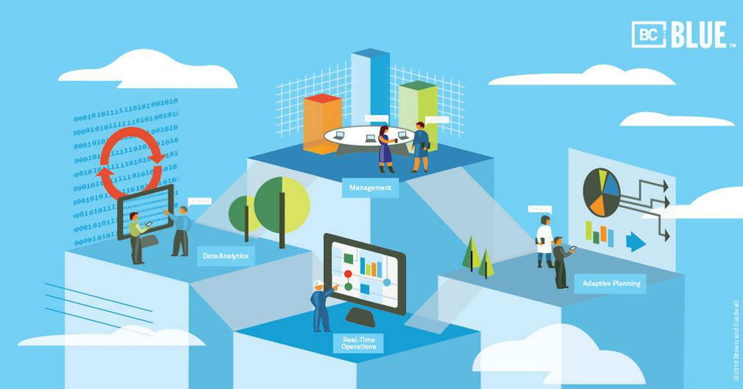Smart Utility: Building A Foundation for Artificial Intelligence
By Michael Karl And Greg Wyatt
With data comes decision-making power, but how each utility wields that power will be different. The Smart Utility approach tailors digital capabilities to arrive at specific and optimal outcomes.
Digital and sensor technologies are advancing at a rapid pace, empowering utilities with the tools needed to optimize operations, enhance levels of service, and manage operating costs as never before. From providing maintenance staff with real-time information to alerting operations of a problem well before it becomes a customer complaint, the possibilities from next-generation technology are far-reaching.
While digital solutions are maturing in other industries, they are just beginning to disrupt the water sector and change the way utilities are managed. It’s increasingly affordable for water utilities to use smart sensors to better gather intelligence and predict sewer overflows, asset failures, and other critical issues with enough time to correct problems and avoid disruptions in service and quality, which ultimately preserve reputation and customer satisfaction. But for utilities to leverage these types of solutions, they must have a solid digital foundation. Utilities really tap into the potential of digital technology when they devise a customized development roadmap to prepare for these advancements and manage the pace of change.
Data, Data Everywhere
Today, much of the water industry is dealing with a combination of data overload and constrained resources, which leads to utilities collecting data they aren’t equipped to analyze, much less take action on. Some estimates report that utilities are reviewing or using less than 10 percent of their data, often overlooking key insights and opportunities to be more efficient. With Internet of Things (IoT) sensors expected to double in the next few years, this challenge will only become more significant. Fortunately, with the advancement and maturity of artificial intelligence (AI) technologies, it’s now possible to effectively review larger data sets and train experienced utility staff to isolate real-world problems from false alerts, enabling them to notify operators and technicians with sufficient lead time to take proactive corrective actions.
However, these transformational technologies have a major requirement: All data has to be aligned with the right architecture. AI systems generally require utilities to have a solid data strategy and sufficient data quality for the AI to monitor and recognize critical patterns that can alert staff of future problems, such as an impending water main break. This can be challenging, as utilities often don’t have a single, unified repository of accurate data that the AI can crunch through. Many utilities currently keep their data siloed across hardcopy formats and digital applications, which prohibits their data from being cross-checked and integrated.
Furthermore, utilities are realizing they can no longer rely only on the experience and expertise of veteran employees and increasingly rely on the integrity of their raw data and analytical capabilities to inform decisions. With baby boomers reaching retirement age and the paper trail of data and institutional knowledge starting to disappear, the next generation of utility staff and water operators needs to fill the knowledge gap quickly. This new generation is digitally savvy and demands user-friendly interfaces that provide realtime information.
As utilities train new staff, manage large volumes of data, and address pressing issues like aging infrastructure and increasingly severe drought conditions, it is becoming critically important to leverage new strategies and decision-making tools to properly prepare staff, guide investment priorities, and maintain (or improve) their baseline levels of service.
The good news is that planning and preparing for this future can be quite cost-effective; in fact, the earlier a strategy is set, the better the savings are. Early adopters are able to take advantage of reduced data migration periods and avoid the need to re-architect each digital application to work together with a central data repository.
Becoming A Smart Utility
Smart Utility — a dynamic and digital approach to utility management — is helping utilities overcome roadblocks like poor data quality or digital silos by connecting information systems and departments to deliver realtime analytics. This approach brings operations, engineering, water quality, and management staff together and integrates systems like supervisory control and data acquisition (SCADA), asset management, customer service, and geographic information systems (GIS) to create dynamic business intelligence dashboards that inform decisions and enable proactive management. Laying the foundation for AI and future digital strategies based upon a secure foundation, Smart Utility provides the flexibility utilities need to adopt higher levels of automation in the future.
The path to Smart Utility starts by defining a vision that aligns a utility’s digital technology with its business objectives. Even if utilities stop there, they will see payback in just a few years by extending the lives of their technology investments. Smart Utility planning informs technology selection, improves data quality, and helps utilities navigate challenges like a changing workforce.
Smart SCADA Integration
SUEZ, one of the nation’s largest investor-owned utility organizations, is building one of the most extensive Smart Utility networks in the country, which is already beginning to receive plaudits from industry peers. In late 2017, the National Association of Regulatory Utility Commissioners recognized SUEZ’s deployment of a state-of-the-art, 1,000-square-mile Smart Utility network with a Utility Industry Innovation in Water and Sewer Award. The company is upgrading its digital applications with a completely new approach to GIS management and recently launched a new stage in its Smart Utility journey. SUEZ is partnering with Brown and Caldwell, a leading environmental engineering and construction firm, to launch a new strategy for its Smart SCADA approach with a focus on building a solid operational platform that fully aligns with its stated mission: “SUEZ will build a Smart Utility by establishing an integrated framework for business applications and SCADA to transform operational information into wisdom.”
SUEZ’s project to establish a Smart SCADA system and foundation for enhanced operational technology in alignment with Smart Utility began in May 2017. The project started with Smart Utility and Smart SCADA planning to identify objectives and pain points with current systems. A cross-functional team was formed and workshops were held where the group collaborated to review the systems currently in operation and the SUEZ technology roadmap to ensure that new investments were sustainable long into the future. With a solid understanding of the state of the industry and their current problems identified through a survey of SUEZ’s Smart Utility applications, the team worked to prioritize a new set of requirements and identify solutions or use cases that were critical to achieving the business and operational objectives. The primary goals are to establish an intuitive standardized SCADA system and to implement tools to increase utility performance and security while reducing operator training time to six months or less.

BC Blue’s powerful set of tools supporting effective utility management
The team worked together to leverage Brown and Caldwell’s Smart Utility standards and SUEZ’s world-class operational expertise to establish a state-of-the-art approach to maximize the capabilities and opportunities available to utilize data and analytics for SUEZ. Through more than 15 workshops, a set of Smart Utility standards and guidelines was finalized in August 2018. Powered with this approach, SUEZ will enable each of its 15 Utility Operations in North America to roll out SCADA upgrades and renewals as their need arises, enabling all-in alignment with the overarching vision and preventing digital misalignment. “We expect this standards and guidelines vision and approach to guide us for 10 or 15 years,” said Greg Wyatt, SUEZ Vice President and Chief Operating Officer of Utility Operations.
All told, SUEZ Utility Operations currently has more than two dozen SCADA systems, each “implemented proprietarily, business unit by business unit,” said Wyatt. Going forward, the SCADA systems will not be identical, but they will work together.
“There are several levels and layers where we will absolutely insist on standardization, such as those where humans interface with the technology and cybersecurity,” said Wyatt. “Other things, like what programmable logic controller you buy for your pump, are not something we’re going to prescribe, but the standards will insist on certain parameters and functionality for the components we buy.”
Establishing this flexibility between standards and guidelines will enable SUEZ to adopt a common digital solution that reduces cost and time in comparison to a traditional approach, while extending the life of the current controller infrastructure.
This is the first time an investor-owned utility has attempted such a large-scale alignment of its SCADA systems.
“A working group of SCADA experts and operations experts from across locations has been formed, and the intention is that the working group will continue to update and improve the standards after this first phase of specs and guidelines has been adopted, so that it may oversee the implementation of new SCADA systems,” Wyatt added. “We can make technology a better partner to inform decisions and increase operational efficiency by leveraging a solid foundation of software and hardware, thus providing our customers and employees with the best service through the proper use and application of operational technology.”
Utilities like SUEZ are capitalizing on the value of Smart Utility planning and implementation to gracefully adapt to technology advancements, increase operational efficiency, and navigate pressing issues like increased demand, finite supply, and water quality.
The company is leveraging BC Blue, Brown and Caldwell’s unique approach to Smart Utility implementation designed specifically for the water industry. BC Blue goes beyond basic data-driven decision-making to enable a new utility paradigm in which utilities are managed to reach optimal efficiency. Within BC Blue is a range of services and solutions that are designed to build upon one another at a pace sensitive to organizational readiness and resources, providing higher returns at each succeeding step. Ultimately, BC Blue equips employees with a powerful set of tools and associated processes, user-friendly interfaces, improved data quality, and AI-enhanced analytics to enable operators and managers to achieve unprecedented utility performance.
About The Authors
 Michael Karl is Brown and Caldwell’s National Smart Utility Technology Leader, responsible for managing and overseeing the firm’s portfolio of smart technology projects including industrial automation projects. He has more than 18 years’ experience in information and operational technology systems like SCADA, Asset Management, and GIS applications; in addition, he is a commissioner and licensed water system operator. He has led some of the nation’s first Smart Utility implementations. He is a seasoned project manager and senior expert having undertaken more than 10 design-build automation projects and 15 technology master plans and has executed more than 40 technology replacement projects. In addition, he has specialized cybersecurity training from the U.S. Department of Homeland Security and training from MIT on artificial intelligence.
Michael Karl is Brown and Caldwell’s National Smart Utility Technology Leader, responsible for managing and overseeing the firm’s portfolio of smart technology projects including industrial automation projects. He has more than 18 years’ experience in information and operational technology systems like SCADA, Asset Management, and GIS applications; in addition, he is a commissioner and licensed water system operator. He has led some of the nation’s first Smart Utility implementations. He is a seasoned project manager and senior expert having undertaken more than 10 design-build automation projects and 15 technology master plans and has executed more than 40 technology replacement projects. In addition, he has specialized cybersecurity training from the U.S. Department of Homeland Security and training from MIT on artificial intelligence.
 Greg Wyatt currently serves as Vice President and Chief Operating Officer of the SUEZ Utility Business, which comprises 15 investor-owned utilities in six states. Prior to this role, he served as Vice President and General Manager of SUEZ’s Idaho utility operations in Boise for more than 18 years. Greg has more than 43 years’ experience in the water industry and has held positions of increasing responsibility in water operations and management, finance, long-term investment, and planning.
Greg Wyatt currently serves as Vice President and Chief Operating Officer of the SUEZ Utility Business, which comprises 15 investor-owned utilities in six states. Prior to this role, he served as Vice President and General Manager of SUEZ’s Idaho utility operations in Boise for more than 18 years. Greg has more than 43 years’ experience in the water industry and has held positions of increasing responsibility in water operations and management, finance, long-term investment, and planning.
